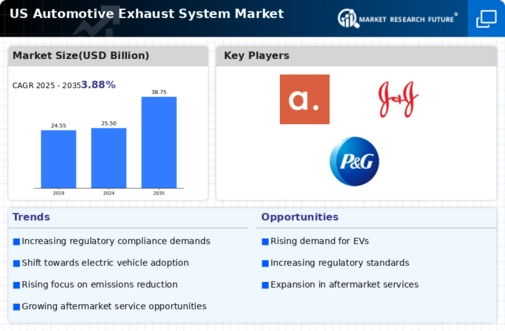Rising Environmental Regulations
The automotive exhaust-system market is experiencing a notable impact from increasing environmental regulations in the US. Stricter emissions standards, such as those set by the Environmental Protection Agency (EPA), compel manufacturers to innovate and enhance their exhaust systems. These regulations aim to reduce harmful emissions, thereby promoting cleaner air quality. As a result, the market is witnessing a shift towards advanced exhaust technologies that comply with these stringent requirements. The demand for catalytic converters and particulate filters is expected to rise, as they play a crucial role in meeting these standards. In 2025, the market is projected to grow by approximately 8% due to these regulatory pressures, indicating a significant transformation in the automotive exhaust-system market as manufacturers adapt to comply with evolving legislation.
Economic Growth and Vehicle Sales
The automotive exhaust-system market is closely tied to the overall economic growth and vehicle sales in the US. As the economy strengthens, consumer confidence rises, leading to increased vehicle purchases. This trend directly impacts the demand for exhaust systems, as each new vehicle requires a compliant exhaust solution. In 2025, the automotive market is expected to grow by approximately 5%, which will subsequently drive the demand for exhaust systems. Additionally, the rise in disposable income allows consumers to invest in higher-quality vehicles, further influencing the market dynamics. This correlation between economic conditions and vehicle sales highlights the importance of macroeconomic factors in shaping the automotive exhaust-system market.
Growth of Electric and Hybrid Vehicles
The automotive exhaust-system market is undergoing a transformation due to the increasing adoption of electric and hybrid vehicles. While these vehicles produce fewer emissions, the need for efficient exhaust systems remains relevant, particularly in hybrid models that utilize internal combustion engines. The market is adapting by developing lightweight and compact exhaust solutions that cater to the unique requirements of these vehicles. As of 2025, the hybrid vehicle segment is projected to grow by 10%, indicating a shift in consumer preferences towards more sustainable options. This growth presents both challenges and opportunities for the automotive exhaust-system market, as manufacturers must innovate to meet the demands of a changing automotive landscape.
Consumer Demand for Performance Vehicles
The automotive exhaust-system market is significantly influenced by the growing consumer demand for high-performance vehicles in the US. Enthusiasts are increasingly seeking vehicles that not only deliver power but also provide an exhilarating driving experience. This trend has led manufacturers to invest in performance-oriented exhaust systems that enhance engine output and sound. The market for aftermarket exhaust systems is also expanding, as consumers look to customize their vehicles for improved performance. In 2025, the performance segment of the automotive exhaust-system market is anticipated to account for approximately 15% of total sales, reflecting a robust interest in performance enhancements. This shift underscores the importance of performance in driving market dynamics and shaping product offerings.
Technological Advancements in Exhaust Systems
Technological advancements are driving the automotive exhaust-system market towards greater efficiency and performance. Innovations such as variable geometry turbochargers and active exhaust systems are becoming increasingly prevalent. These technologies not only enhance engine performance but also contribute to reduced emissions, aligning with consumer demand for more efficient vehicles. The integration of smart sensors and control systems allows for real-time monitoring and adjustment of exhaust flow, optimizing performance under various driving conditions. As of 2025, the market is expected to see a growth rate of around 7%, largely fueled by these technological innovations. This trend indicates a shift towards more sophisticated exhaust solutions that cater to the evolving needs of consumers and regulatory bodies alike.














Leave a Comment